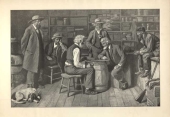The Checker Maven
The World's Most Widely Read Checkers and Draughts Publication
Bob Newell, Editor-in-Chief
Published each Saturday morning in Honolulu, Hawai`i
Basic Checkers, 2010 Edition
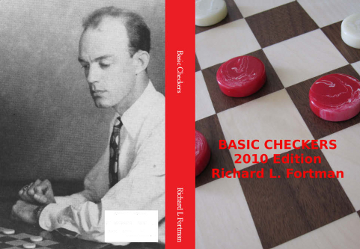
We're giving over much of this week's column to unabashed advertising, but when you read the rest, you'll surely support our efforts, and will be confident we haven't abandoned our non-commercial policies.
For years, Richard Fortman's Basic Checkers has been the veritable bible for 3-move checker players. Certainly, new works such as Solid Checkers, The Golden Dozen, and others, have come on the scene to correct, supplement, and expand upon Mr. Fortman's original work, going beyond the 137 opening ballots in use 30 years ago. But every serious checkerist is likely to have studied Basic Checkers at some point, and may even have a copy of the original seven self-published, typewritten, spiral-bound booklets.
The Checker Maven is proud to announce that a newly typeset, professionally bound and printed edition of Basic Checkers is now available. Your editor, in conjunction with Jim Loy, John Acker, and artist Louisa Gilani have combined forces to produce this new 2010 edition, with all seven volumes in one 6x9, 504 page trade paperback, which is being sold at a price that nearly anyone can afford. Completely reformatted and set in clear, readable type, it is our hope that this work, which is now hard to find and expensive even if found, will once again be placed in the hands of checker players everywhere.
100% of net income will go to the American Checker Federation Youth Fund in honor of Mr. Fortman.
The book will be sold at the Nationals this August for just $25.00. If you can't be at the Nationals, you can get a copy online through CreateSpace. Additionally, the book will be available in a few weeks directly from Amazon or by special order in bookstores, for $30.00 plus shipping.
And now, let's look at a problem position taken from the book. It stems from the 9-13, 24-19, 6-9 opening.
Game: 9-13, 24-19, 6-9, 22-18, 11-15, 18-11, 8-24, 28-19, 4-8, 25-22,8-11, 22-18, 9-14, 18-9, 5-14, 29-25, 11-15---A, 19-16, 12-19, 23-16, 1-6---B, 27-23, 7-11,16-7, 2-11, 25-22, 3-8, 32-27---C, 8-12,27-24, 11-16, 24-20, 16-19, 23-16, 12-19,22-17, 13-22, 26-17, 14-18, 20-16, 18-23,16-11, *6-9, 17-13, 9-14, 11-8, 23-27, 31-24, 19-28, 8-3, 15-19, 3-7, 10-15, 7-11,14-18, 30-26---D.
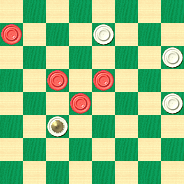
BLACK
Black to Play and Draw
B:W26,21,13,K11:B28,19,18,15.
Notes A to D below are excerpted from Basic Checkers with minor editing.
A---Instead of 1-6.
B---Instead of 1-6, Freyer v. Zuber in the 1981 Florida Open played 14-18, into Banks-Hellman, 2nd National Checkers Association Tournament.
C---Here 31-27 is usual, then 8-12, 27-24, 11-16, 24-19, 15-24, 23-19, 16-23, 26-19, 13-17, 22-13, 14-18, 30-26, etc., drawn. Credited to Denvir and Bradford. The text would seem to be a fine vary, used by the late Colorado master on mail play.
D---Forms a fine problem to arise in play--- Black to move and draw.
Basic Checkers, despite the title, is a rather advanced work, but the problem above isn't as difficult as you might think. Solve it and then click on Read More for the snappy solution ... and then order your copy of the book!![]()
Willie's Windmill

Willie's title for this entry in his fabled Tricks Traps & Shots of the Checkerboard is appropriately named, for at least two reasons. One is that the solution to Willie's position resembles, in an imaginative way, the action of a windmill as represented on a checkerboard. The other reason is that Willie seems to have been tilting at windmills a bit, and makes a most atypical misjudgment of the final outcome. Let's have a look and a listen as Willie sets forth his premise.

"This time we have a combination in-and-out shot of the type most frequently missed in actual play. The experts seldom 'muff' a straight or ordinary in-and-outer, but there are many kinds of in-and-outs, and the more complex varieties are often overlooked, even by top-flight champions.
| 11-16 | 19-16---1 | 2-7 |
| 22-18 | 12-19 | 22-18 |
| 16-20 | 23-16 | 8-11 |
| 25-22 | 5-9 | 32-27 |
| 10-14 | 16-12 | 14-17---A |
| 29-25 | 7-10 | 21-14 |
| 8-11 | 27-23 | 10-17 |
| 18-15 | 10-19 | 23-19 |
| 11-18 | 23-16 | 9-14 |
| 22-15 | 1-5 | 18- 9 |
| 9-13 | 25-22 | 5-14 |
| 24-19 | 6-10---2 | 31-26---B, |
| 4-8 | 26-23 | results in the diagram. |

BLACK
Black to Play and Draw
B:W30,28,27,26,19,16,12:B20,17,14,13,11,7,3.
The original terms of this position were Black to Play and Win---Ed.
A---If black plays 13-17 here, white brings home the draw with this timely stroke: 13-17, 18-15*, 11-18, 12-8*, 3-26, 31-22-15-6, 7-11, 6-2, 11-15, 2-6, 9-13, 6-9, 14-18, 21-14, 15-19, 30-26, 13-17, 9-13, 17-22, 26-17, 19-23. Wm. F. Ryan.
B---Caught and caged! Black now executes a whirlwind shot with a double-action in-and-outer. Of course, 30-26, 17-21, 26-22*, 21-25,19-15, 11-18, 22-15, 14-18, 15-11, 7-10,12-8, 3-19, 27-24, will corral a draw easily. Wm. F. Ryan."
1---28-24 might be better here as Black now gets a small advantage---Ed.
2---14-17 would have held Black's small edge---Ed.
Can you find the combination shot that draws (not wins) for Black, or will you tilt at windmills yourself? Work it out and spin your mouse to Read More to see the solution and a bit more analysis.![]()
Tangled Skeins

The title for today's Checker School lesson, taken from Ben Boland's Famous Positions in the Game of Checkers, has less to do with the position itself than with the commentary that follows it in the original book. We'll look at the position first, and we'll discuss the commentary in the solutions section of our column.
BLACK

WHITE
White to Play and Draw
W:W13,18,K19:B5,6,12,K28.
White seeks to obtain a man-down draw; as usual, there are compensatory factors that must be relied upon to make up for the material deficit. Here, White's better mobility seems to be his only edge, but whether or not that's enough depends on the skill and technique of the White checkerist.
Can you untangle this one, or will it remain a knotty problem? No worries, you can click on Read More to unwind the solution, explanatory notes, and a sample game, as well as viewing the "Tangled Skeins" commentary.![]()
Russell's Crocodile

We're not at all sure we understand the title of this month's selection from Willie Ryan's Tricks Traps & Shots of the Checkerboard. The entry is labeled "Russell's Crocodile" yet it is all about the Alligator Position! Crocodiles and alligators are most assuredly different creatures; while they are varieties of crocodilians, they respectively belong to the crocodylidae family and the alligatoridae family. Furthermore, according to website wisegeek.com:
"... the crocodile's upper and lower jaws are nearly the same width, so the teeth are exposed all along the jaw line in an interlocking pattern, even when the mouth is closed ... An alligator ... has a wider upper jaw, so when its mouth is closed the teeth in the lower jaw fit into sockets of the upper jaw, hidden from view. Only the teeth of the upper jaw are exposed along the lower jaw line."
We don't know why Willie mixed his metaphor, so to speak; perhaps it is because his expertise ran stronger in checkers than it did in biology. But we can all be grateful for that, as Willie today gives us an entertaining example of the Alligator Position.

"For sheer brilliance, none of the previously illustrated sparkling gems devised by the great men of draughts shines brighter than the renowned Alligator Position. It was first published as a problem by W. H. Russell at the stage diagrammed below. Later, Southern States Champion F. B. Fishburne, of Columbia, South Carolina, showed how it could arise scientifically in play. Fishburne dubbed it the Alligator Position, 'because it had such a wicked tail-end snap,' and that appropriate appellation has held fast.
| 9-13 | 24-19 | 11-16 |
| 22-17 | 16-23 | 26-23 |
| 13-22 | 26-19 | 16-20 |
| 25-18 | 6-10 | 31-27---3 |
| 11-16 | 25-21 | 2-7---4 |
| 29-25 | 10-17 | 24-19 |
| 5-9 | 21-14 | 7-11---5 |
| 18-14 | 11-16 | 14-10 |
| 9-18 | 28-24 | 11-16 |
| 23-14 | 16-23 | 18-15 |
| 10-17 | 27-18 | 4-8---A. |
| 21-14 | 7-11 | See the |
| 8-11 | 30-26 | diagram. |
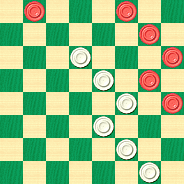
WHITE
White to Play and Win
W:W10,15,19,23,27,32:B1,3,8,12,16,20.
A---Loses, and forms the Alligator Position. 1-5 will produce a draw with careful play---6."
3---This move loses and we're surprised Willie didn't flag it. Correct was 23-19 to a probable draw. After 31-27 2-6 4-8 White cannot avoid the loss of a piece---Ed.
4---But White misses the win with 2-6---Ed.
5---The computer engine KingsRow really doesn't like this move and calls it a probable loss. 1-6 was correct---Ed.
6---However the computer sees this as a dead loss, instead choosing 3-8 in an already hopeless position. See Note 5 above---Ed.
Whatever species you may prefer--- alligator or crocodile--- can you get your teeth around this problem? After you've chewed on it for a while, snap your mouse on Read More to see the solution.![]()
Merry - Strickland
There's Merry Hill, and the Merry Hill Shopping Mall, on the Dudley Number One canal, perhaps 10 miles from Birmingham in the U.K. It looks to be a nice setting; we suspect it might tend a bit to the industrial side, but we've not been there to verify.

And there's the Strickland Avenue waterfall, a most assuredly beautiful setting located somewhere in Tasmania. Of course we haven't been there either.
Now, we know for sure that checkers is played in the U.K. and in Tasmania. We know that in the 1880s, checkerists Merry and Strickland published various items of checker analysis (hence today's Checker School lesson). Therefore, a little deductive logic tells us that since Merry published in the American magazine Turf, Field, and Farm he was very likely an American checkerist, and hence Merry Hill is surely not named after him. Checkerist Strickland who published in the Glasgow Weekly Herald, was undoubtedly from the British Isles, making it most unlikely that a street in Tasmania was named after him (although one never knows).
What we can say is that the Merry and Strickland checker settings do indeed possess checkeristic elegance and appeal. Here is the main position.
BLACK
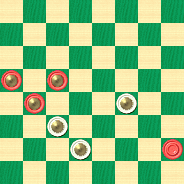
WHITE
White to Play, Black Wins
W:WK14,K11,K7:BK20,K19,K16,5.
Black is a piece up and of course that is supposed to mean an eventual, if not a straightforward win. But given White's centralized king positions, Black is going to have to work hard and patiently to achieve victory. The winning procedure in fact requires a high level of technique and is very much worth mastering.
So, sail down the canal but don't go over the falls; instead, make Merry and find the solution. Then click on Read More to see detailed notes and explanations as well as a sample game.![]()
The Big Squeeze
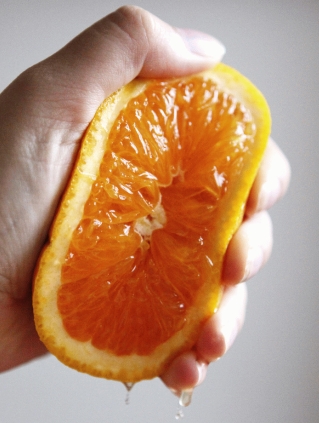
There's nothing so good as fresh-squeezed juice as a morning pick-me-up; it just can't compare with cardboard cartons, concentrates, or powders. However, we do recommend a somewhat different squeezing method than that shown in the photo above; at the very least, you might wish to squeeze your juice into a cup or glass instead of onto your hands or onto the table.
There are squeezes in checkers, too, and although they don't directly produce juice, they just might produce a nice victory. Willie Ryan, in his classic work Tricks Traps & Shots of the Checkerboard, has a page or two on squeeze plays, and he's here in print to explain to us just how it works.

"One of the most unusual games I ever won was the strange coup I sprung on the renowned John T. Bradford of Philadelphia, a member of the American International Checker Team of 1927, in the American Championship Tourney of 1937; and I believe it is the only win of its kind on the published record. The game leading up to this peculiar situation is reproduced on the next page, exactly as we played it.
| 10-14 | 9-14---A | 15-24 |
| 23-18 | 18-11 | 28-19 |
| 14-23 | 7-16 | 2-7 |
| 27-18 | 26-23 | 31-26 |
| 12-16 | 4-8 | 1-6 |
| 32-27 | 22-17 | 22-18 |
| 16-20 | 8-12 | 14-17 |
| 26-23 | 25-22 | 21-14 |
| 6-10 | 3-7 | 10-17 |
| 30-26 | 24-19 | 25-21 |
| 11-15 | 7-11 | 6-10 |
| 18-11 | 17-13 | 21-14 |
| 8-15 | 11-15 | 10-17 |
| 23-18 | 29-25 | 19-15---B |
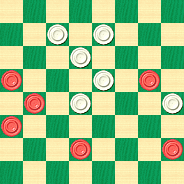
BLACK
Black to Play and Win
B:W27,26,23,18,15,13:B20,17,16,12,7,5.
A---First introduced by me at the 1937 American Championship Tourney, departing from the usual line by 7-11.
B---The wrong one. A draw is gained easily with: 18-14*, 7-11, 13-9, 17-21, 9-6, 21-25, 6-2, 25-30, 2-7, 11-15, 19-10, 16-19. After 19-15, black starts the biggest squeeze play on record, going all the way from square 7 to square 22 before regaining the sacrificed piece."
Willie certainly gives a giant hint in his second note, but we still believe you'll have to give this one a little thought to squeeze out the solution. Find the Black win and then squeeze the mouse button over Read More to see the answer.![]()
Great Men Like Checkers

There's no doubt that many a great man was a checkerist, and you'll see why we've chosen the title Great Men Like Checkers for today's Checker School column when you read through the solution section.
The definition of a great man can vary. Some think of great national leaders, others think of religious figures, and still others might vote for sports heroes. There is room for all of these, and more. Our photo above shows a great baseball player from the olden days, Christy Mathewson, who besides being a baseball Hall of Famer, was also a master checker player.
On the other hand, few people remember checkerist Fred Allen; and thought he might not be a member of the Hall of Fame, he is credited with a very fine and instructive checker position, which forms the subject of our column today. In our opinion, it's more than enough to secure Mr. Allen's place in checker history.
WHITE
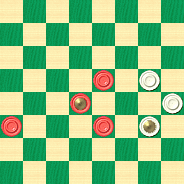
BLACK
Black to Play and Win
B:W17,13,K9:B18,K15,12,10.
It's an intriguing layout: the near-symmetry of the three per side on the right offset by the lone extra Black man on square 12. Is it enough for a Black win? According to Mr. Allen, it is indeed, but it's all in knowing how. Can you demonstrate your own checker greatness by showing how it's done? Solving the problem likely won't make you into a Hall of Famer, but work it through and then click on Read More to see the solution, no less than five sample games (this is indeed a practical exercise), and explanatory notes.![]()
Martins' Masterpiece

We'd likely be correct if we were to claim that when we say the word "masterpiece" an image such as the painting above, Da Vinci's incomparable Mona Lisa, would come to mind. Certainly it's something that will be recognized for all time as a great work of art.
Of course, great artistry exists in many fields of human endeavor. Much as there are renowned painters, there are sculptors, poets, composers, and more. There is an artistry to our game of checkers too, as most experienced practitioners are surely aware. Now, we won't say checker artistry quite reaches the level of Mona Lisa, but it can still be quite amazing.
One of checker's greatest artists had to have been Willie Ryan, and in his book Trips Traps & Shots of the Checkerboard, he collected more than a few checker masterpieces. Today, he'll tell us about one that he calls Martins' Masterpiece.

"Here is how the redoubtable Robert Martins vanquished an unwary adversary with a blaze of sudden fireworks on the ending of a Whilter game. This stroke is considered by many authorities to be the best concealed sweep recorded in checker literature.
| 11-15 | 8-11 | 10-17 |
| 23-19 | 31-26 | 21-14 |
| 9-14 | 16-20 | 11-15 |
| 22-17 | 19-16 | 18-11 |
| 7-11 | 12-19 | 9-18 |
| 25-22 | 23-16 | 30-21 |
| 11-16 | 14-18 | 18-22 |
| 26-23 | 26-23 | 24-19 |
| 5- 9 | 18-22 | 22-26 |
| 17-13 | 25-18 | 28-24 |
| 3- 7 | 15-22 | 26-30 |
| 29-25 | 23-18 | 21-17 |
| 1- 5 | 22-25 | 30-26---A, 2 |
| 22-17 | 17-14 | This takes you |
| to the diagram. |
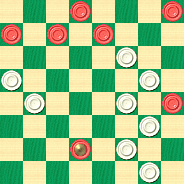
WHITE
White to Play and Win
W:W11,13,16,17,19,24,27,32:B2,4,5,6,7,K26,20.
A---This is where Martins lowered the boom. Bringing out the king 30-25 lands a draw easily with the following play: 30-25, 17-14, 6-10, 14-9, 5-14, 13-9, 14-18, 9-6, 2-9, 11-2, etc."
2---The game was played perfectly by both sides up to this point, but a single mistake is more than enough to end the game---Ed.
Demonstrate your own checker artistry by finding the win. We have to agree that it's a masterpiece in its own right. To see the solution, brush your mouse on Read More.![]()
Blither's Advice
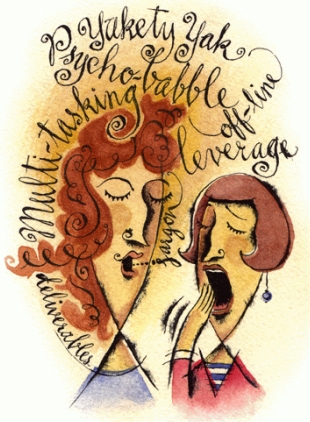
There are people who talk a lot, and despite our illustration above, we don't at all mean to stereotype this behavior. Copious yakking knows no boundaries of gender, group, or anything else.
At times, wordiness can be most beneficial. For instance, our monthly Checker School columns usually contain rather verbose advice and explanation, and we think that's a good thing, as it makes the lessons easier to learn and apply. But this month, Ben Boland, the original source of our current pedagogical series, is untypically laconic. Is it because the material is easier than usual? Or was Mr. Boland having an especially quiet day? We can't know the answer, but we can have a look at the subject study, which traces back to a certain L. J. Vair.
WHITE
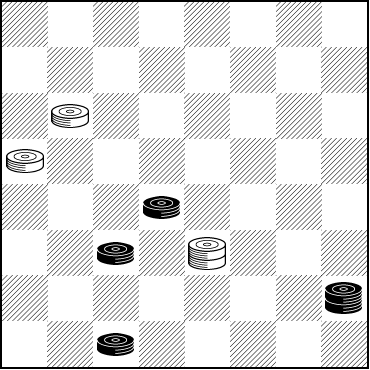
BLACK
Black to Play and Win
B:W24,20,K10:B15,11,K5,3.
You might say that the position speaks for itself; Black is a man up and ought to be able to win. Yet, it's trickier than you might think at first glance. Can you get the last word on this problem or will it leave you speechless? We're only going to say that clicking on Read More will bring you to the solution, a sample game, and explanatory notes.![]()
Scott's Scorcher

The expression "hot stuff" has a number of different meanings and uses, and our photo above is a real scorcher in its own right. Scorchers exist as well in our game of checkers, and who else is as uniquely qualified as Willie Ryan to discuss them? Mr. Ryan, who was "hot stuff" of the checker sort in his own day, calls the following play "Scott's Scorcher" in his book Tricks Traps & Shots of the Checkerboard. Let's let Willie tell us more.

"We found the Dyke game and stroke, described here, hidden in an old tome, credited to W. Scott, and it is altogether too good to pass by unnoticed. In this example, the winning clearance is effected by employing one of those peculiar in-and-out devices so widely used in stroke strategy.
| 11-15 | 27-23 | 9-14 |
| 22-17 | 4- 8 | 23-19 |
| 15-19 | 23-16 | 11-15 |
| 24-15 | 11-20 | 19-16---3 |
| 10-19 | 29-25 | 15-19---4 |
| 23-16 | 7-10 | 31-27---A |
| 12-19 | 17-13 | 3-8 |
| 25-22 | 8-11 | 16-12---B |
| 8-11 | 26-23 | See the |
| diagram. |
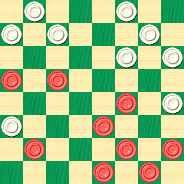
BLACK
Black to Play and Win
B:W32,30,28,27,25,22,21,13,12:B20,19,14,10,8,6,5,2,1.
A---White dares not play 16-11, as black will force white into this crushing coup: 16-11, 10-15, 31-27---5, 14-17*!, 21-14, 19-23, 27-18, 6-9, 13-6, 1-26, 30-23, 15-29. A very unusual 'double-take.'
B---The beginning of the end. However, white still can pull out with a draw, by: 30-26*---6, 10-15, 13-9*, 6-13, 16-12, 8-11, 27-24, 20-27, 32-7, 2-11, 26-23, 11-16, 28-24, 16-20, 23-19, 20-27, 19-10, 27-31, 10-7, 31-26, 7-2, 26-17, 2-7, 1-6, 12-8, 5-9, 7-11, 17-22, 25-18, 14-23, 11-15, 23-26, 8-3, 26-30, 3-7, 9-14, 7-2, 6-9, 2-6, 30-26, 15-10. Wm. F. Ryan."
3---This move may actually lose. 32-27 is much to be preferred here---Ed.
4---Gives back the edge; 20-24 would have retained the substantial advantage for Black---Ed.
5---White would do better here with 22-17, although the game may still be lost---Ed.
6---In a line of play that probably only a computer would find, KingsRow shows that the surprising move 13-9 will also draw here as White pulls off a stroke of his own: 13-9 6x13 16-12 8-11 27-24 20x27 32x7 2x11 etc. Drawn---Ed.
Are you "hot stuff" yourself? (Remember, we're talking checkers here.) Demonstrate your elevated temperature by solving the problem; but if you get overheated, clicking on Read More will take you straight to the solution.![]()
The Checker Maven is produced at editorial offices in Honolulu, Hawai`i, as a completely non-commercial public service from which no profit is obtained or sought. Original material is Copyright © 2004-2025 Avi Gobbler Publishing. Other material is public domain, as attributed, or licensed under Creative Commons. Information presented on this site is offered as-is, at no cost, and bears no express or implied warranty as to accuracy or usability. You agree that you use such information entirely at your own risk. No liabilities of any kind under any legal theory whatsoever are accepted. The Checker Maven is dedicated to the memory of Mr. Bob Newell, Sr.


